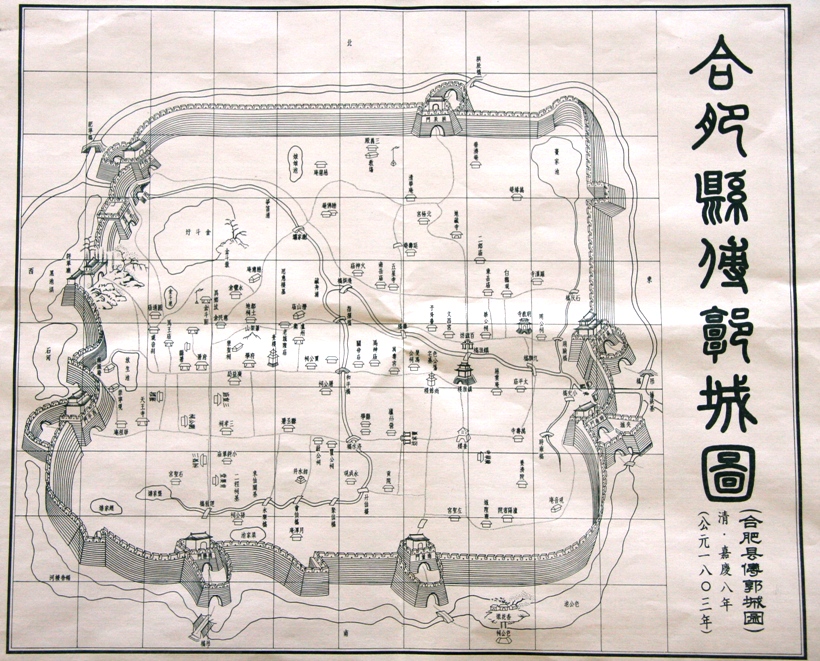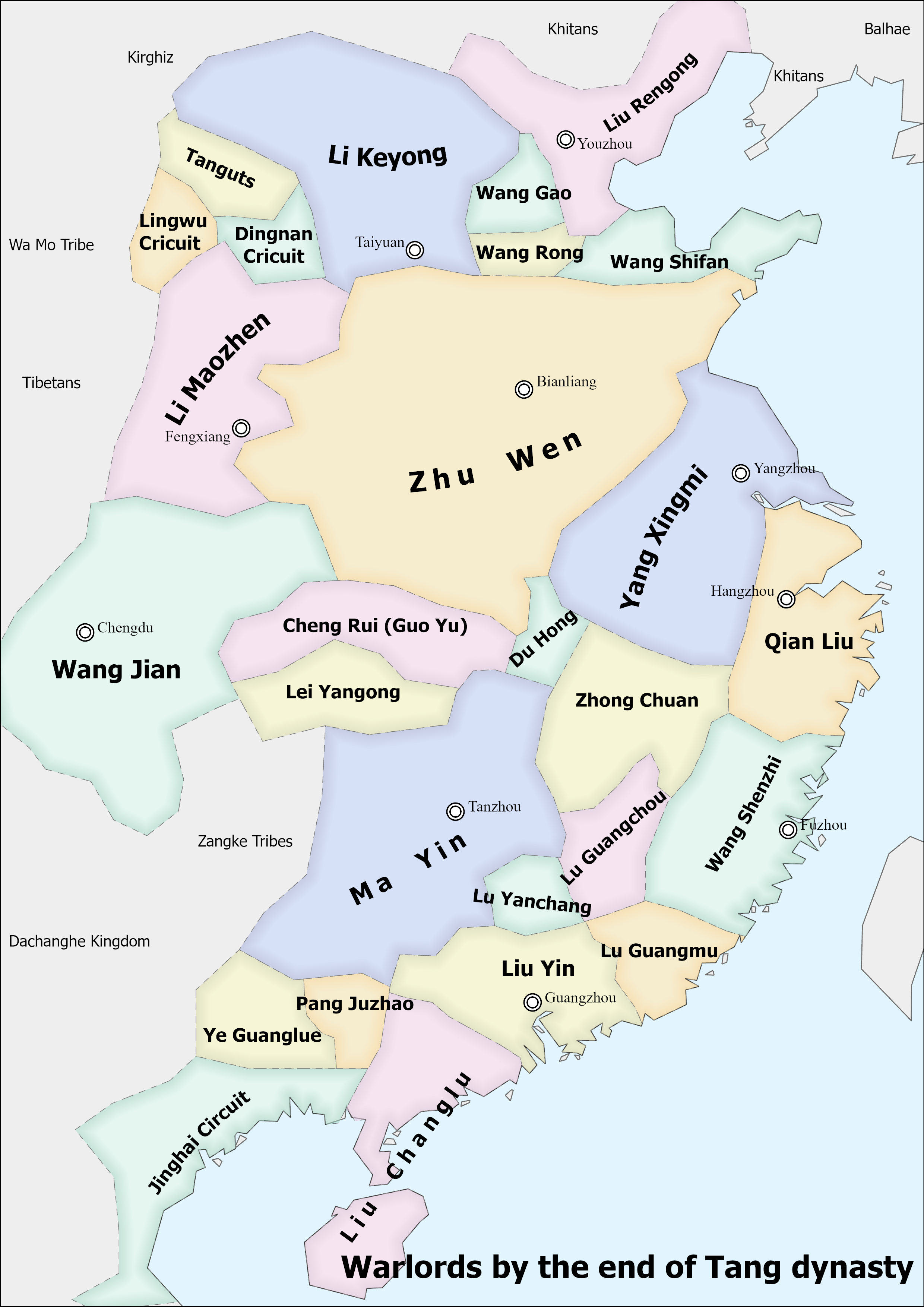|
Xu Wen
Xu Wen () (862''New History of the Five Dynasties'', vol. 61. – November 20, 927''Zizhi Tongjian'', vol. 276.Academia Sinicabr>Chinese-Western Calendar Converter), courtesy name Dunmei (), formally Prince Zhongwu of Qi (), later further posthumously honored Emperor Wu () with the temple name Yizu () by his adoptive son Xu Zhigao after Xu Zhigao founded the state of Southern Tang, was a major general and regent of the Chinese Five Dynasties and Ten Kingdoms period state Wu. He took over the reins of the Wu state (then also known as Hongnong) after assassinating, with his colleague Zhang Hao, Yang Wo, the first Prince of Hongnong, and then killing Zhang. Xu was in essence the decision-maker throughout the reign of Yang Wo's brother and successor Yang Longyan and the first part of the reign of Yang Longyan's brother and successor Yang Pu. After his death, Xu Zhigao inherited his position as regent, eventually seizing the Wu throne and establishing Southern Tang. Ba ... [...More Info...] [...Related Items...] OR: [Wikipedia] [Google] [Baidu] |
Wu (Ten Kingdoms)
Wu (), also referred to as Huainan (), Hongnong (), Southern Wu (), or Yang Wu (楊吳), was a Dynasties in Chinese history, dynastic state of China and one of the Five Dynasties and Ten Kingdoms period#Ten Kingdoms, Ten Kingdoms during the Five Dynasties and Ten Kingdoms period. It existed from 907 to 937 with capital at Jiangdu Municipality (; modern-day Yangzhou, Jiangsu, Jiangsu Province). Some historians consider Wu to have begun in 902, when Yang Xingmi was named Prince of Wu by the Tang dynasty. All three rulers of Wu after 907 (when the Tang dynasty collapsed and Zhu Wen established the Later Liang (Five Dynasties), Later Liang dynasty) were Yang Xingmi's sons. The first ruler Yang Wo was murdered by his ministers Xu Wen and Zhang Hao (general), Zhang Hao, and his two brothers after him were effectively puppets dominated by Xu Wen at first, and later Xu Wen's adopted son Li Bian, Xu Zhigao (Li Bian) who in 937 usurped power to establish the Southern Tang, Southern Tang d ... [...More Info...] [...Related Items...] OR: [Wikipedia] [Google] [Baidu] |
Yang Wo
Yang Wo () (886 – June 9, 908), courtesy name Chengtian, also known by his temple name as the Emperor Liezu of Yang Wu (), was the first independent ruler of the Chinese Yang Wu dynasty during the Five Dynasties and Ten Kingdoms period, reigning as the Commandery Prince of Hongnong. Background Yang Wo was born in 886, during the reign of Emperor Xizong of Tang. He was the oldest son of Yang Xingmi, who was then the prefect of Lu Prefecture (廬州, in modern Hefei, Anhui).''Zizhi Tongjian'', vol. 256. His mother was Yang Xingmi's concubine Lady Shi, who was also the mother to his younger brother Yang Longyan. He had four other younger brothers, Yang Meng, Yang Pu, Yang Xun (), and Yang Che ().'' Spring and Autumn Annals of the Ten Kingdoms'' (十國春秋)vol. 4 During Yang Xingmi's rule of Huainan The first historical reference to Yang Wo's acts was in 904, by which time Yang Xingmi had become a major warlord in control of Huainan Circuit (淮南, headquartered ... [...More Info...] [...Related Items...] OR: [Wikipedia] [Google] [Baidu] |
Xuancheng
Xuancheng ( zh, s=宣城, p=Xuānchéng''; Xuanzhou Wu dialects, Xuanzhou Wu:'' Shye-san) is a city in the southeast of Anhui province. Archeological digs suggest that the city has been settled for over 4,000 years, and has been under formal administration since the Qin dynasty. Located in the lower Yangtze River drainage basin and Yangtze River Delta, it borders Wuhu City, Wuhu to the northwest, Chizhou to the west, Huangshan City, Huangshan to the southwest, and the coastal provinces of Zhejiang and Jiangsu to the southeast and northeast respectively. History Archeological digs in Xuancheng have found pottery and stoneware indicative of the Liangzhu culture, Liangzhu Culture. During the Spring and Autumn period, the area belonged to the Wu (state), State of Wu, although, upon the Battle of Lize, decline of Wu, the area was also ruled by the Chu (state), State of Chu and the Yue (state), State of Yue, respectively. Under the Qin dynasty, the area was administered as Zhang Comma ... [...More Info...] [...Related Items...] OR: [Wikipedia] [Google] [Baidu] |
Yangzhou
Yangzhou is a prefecture-level city in central Jiangsu Province, East China. Sitting on the north bank of the Yangtze, it borders the provincial capital Nanjing to the southwest, Huai'an to the north, Yancheng to the northeast, Taizhou, Jiangsu, Taizhou to the east, and Zhenjiang across the river to the south. Its population was 4,559,797 at the 2020 Chinese census, 2020 census and its urban area is home to 2,635,435 inhabitants, including three urban districts, currently in the agglomeration. Historically, Yangzhou was one of the wealthiest cities in China, known at various periods for its great merchant families, poets, artists, and scholars. Its name (lit. "Rising Prefecture") refers to its former position as the capital of the ancient Yangzhou (ancient China), Yangzhou prefecture in Administration of territory in dynastic China, imperial China. Yangzhou was one of the first cities to benefit from one of the earliest World Bank loans in China, used to construct Yangzhou therma ... [...More Info...] [...Related Items...] OR: [Wikipedia] [Google] [Baidu] |
Sun Ru
Sun Ru (; died July 3, 892Academia Sinicabr>Chinese-Western Calendar Converter''Zizhi Tongjian'', vol. 259.), formally the Prince of Le'an (), was a Chinese military general, rebel and politician during the Tang dynasty. He initially served as a general under the pretender emperor Qin Zongquan. After Qin's defeat, he nominally submitted to Tang imperial authority and contended for control of the central-lower Yangtze River region with Yang Xingmi; he was eventually defeated by Yang and executed. His subordinate Ma Yin was the eventual founder of the Five Dynasties and Ten Kingdoms period state Chu. Background and service under Qin Zongquan It is not known when Sun Ru was born. His family was from Henan County, one of the two counties making up the Tang dynasty eastern capital Luoyang. At some point, he became a low-level officer at Zhongwu Circuit (忠武, headquartered in modern Xuchang, Henan), where he befriended fellow officer Liu Jianfeng. Later, during the rebellion ... [...More Info...] [...Related Items...] OR: [Wikipedia] [Google] [Baidu] |
Anhui
Anhui is an inland Provinces of China, province located in East China. Its provincial capital and largest city is Hefei. The province is located across the basins of the Yangtze and Huai rivers, bordering Jiangsu and Zhejiang to the east, Jiangxi to the south, Hubei and Henan to the west, and Shandong to the north. With a population of 61 million, Anhui is the 9th most populous province in China. It is the 22nd largest Chinese province based on area, and the 12th most densely populated region of all 34 Chinese provincial regions. Anhui's population is mostly composed of Han Chinese. Languages spoken within the province include Lower Yangtze Mandarin, Wu Chinese, Wu, Huizhou Chinese, Hui, Gan Chinese, Gan and small portion of Central Plains Mandarin. The name "Anhui" derives from the names of two cities: Anqing and Huizhou, Anhui, Huizhou (now Huangshan City). The abbreviation for Anhui is , corresponding to the historical , and is also used to refer to the Wan River and Mount Ti ... [...More Info...] [...Related Items...] OR: [Wikipedia] [Google] [Baidu] |
Hefei
Hefei is the Capital city, capital of Anhui, China. A prefecture-level city, it is the political, economic, and cultural center of Anhui. Its population was 9,369,881 as of the 2020 census. Its built-up (or ''metro'') area is made up of four urban districts plus Feidong, Feixi and Changfeng counties being urbanized, and was home to 7,754,481 inhabitants. Located in the central portion of the province, it borders Huainan to the north, Chuzhou to the northeast, Wuhu to the southeast, Tongling to the south, Anqing to the southwest and Lu'an to the west. A natural hub of communications, Hefei is situated to the north of Chao Lake and stands on a low saddle crossing the northeastern extension of the Dabie Mountains, which forms the divide between the Huai River, Huai and Yangtze rivers. The present-day city dates from the Song dynasty. Before World War II, Hefei remained essentially an administrative centre and the regional market for the fertile plain to the south. It has gone thro ... [...More Info...] [...Related Items...] OR: [Wikipedia] [Google] [Baidu] |
Yang Xingmi
Yang Xingmi (; 852'' Spring and Autumn Annals of the Ten Kingdoms''vol. 1 – December 24, 905Academia Sinicabr>Chinese-Western Calendar Converter''Zizhi Tongjian'', vol. 265.), né Yang Xingmin (楊行愍, name changed 886), courtesy name Huayuan (), formally Prince Wuzhong of Wu (吳武忠王, "martial and faithful"),Yang Xingmi's title of ''Wang'' (王) is translatable in English as either "prince" or "king." It will be largely translated as "prince" here as he made no attempt to claim his domain to be a state independent from Tang dynasty, and it was not until the time of his son Yang Longyan (King Xuan), by which time the Tang imperial line had long been extinguished, that the Wu state formally declared itself independent, that the Wu rulers claimed the title of ''Guowang'' (lit., "state prince/king"). However, "king" will be used for the posthumous honors that Yang Longyan bestowed on him as Yang Longyan was then claiming the ''Guowang'' title. See ''Zizhi Tongjian'', v ... [...More Info...] [...Related Items...] OR: [Wikipedia] [Google] [Baidu] |
Jiangsu
Jiangsu is a coastal Provinces of the People's Republic of China, province in East China. It is one of the leading provinces in finance, education, technology, and tourism, with its capital in Nanjing. Jiangsu is the List of Chinese administrative divisions by area, third smallest, but the List of Chinese administrative divisions by population, fifth most populous, with a population of 84.75 million, and the List of Chinese administrative divisions by population density, most densely populated of the 22 provinces of the People's Republic of China. Jiangsu has the highest GDP per capita and second-highest GDP of Chinese provinces, after Guangdong. Jiangsu borders Shandong in the north, Anhui to the west, and Zhejiang and Shanghai to the south. Jiangsu has a coastline of over along the Yellow Sea, and the Yangtze flows through the southern part of the province. Since the Sui dynasty, Sui and Tang dynasty, Tang dynasties, Jiangsu has been a national economic and commercial center ... [...More Info...] [...Related Items...] OR: [Wikipedia] [Google] [Baidu] |
Lianyungang
Lianyungang () is a prefecture-level city in northeastern Jiangsu province of China, province, China. It borders Yancheng to its southeast, Huai'an and Suqian to its south, Xuzhou to its southwest, and the province of Shandong to its north. Its name derives from Lian Island, the largest island in Jiangsu which lies off its coastline, and Yuntai Mountain, the highest peak in Jiangsu, a few miles from the city center, and the fact that it is a port. The name can be literally translated as the Port Connecting the Clouds. Lianyungang was home to 4.65 million inhabitants as of the 2020 census whom 1,210,767 lived in the built-up (''or metro'') area made of Haizhou and Lianyun counties. Lianyungang was known in the West as Haichow (Postal romanization), which means the City of Sea. Haichow was opened to foreign trade by the Qing imperial government in 1905. Geography Lianyungang is between 118°24' and 119°48' east longitude and 34°11' and 35°07' north latitude. Lianyungang covers ... [...More Info...] [...Related Items...] OR: [Wikipedia] [Google] [Baidu] |




